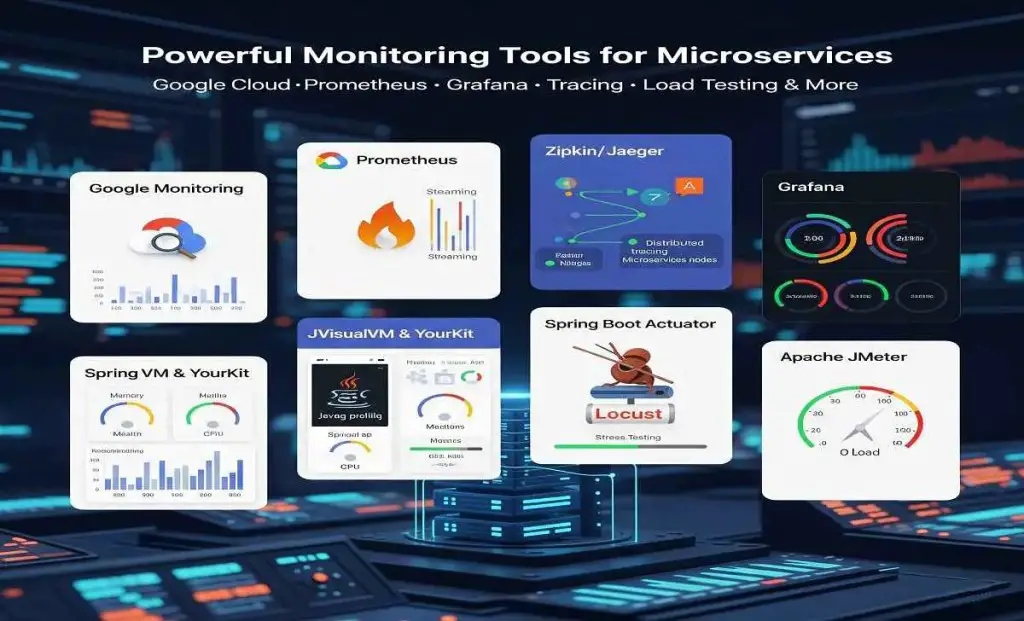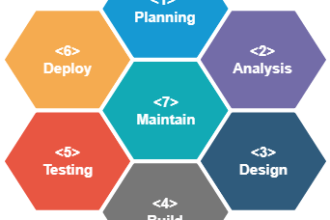Let’s explore the best microservice monitoring tools. They help you test your services, find and fix bugs, and keep an eye on how your infrastructure is performing — all in real time.

Why Need Tools for Microservice Monitoring?
It is sometimes important to test, debug, and track the performance of your microservices. But how to do it and how to select a tool that is easy and simple to use.
List of Best Microservice Monitoring Tools
We’ve laid down the most commonly available microservice monitoring tools. Check out what each tool has to offer and which one fits the best in your use case.

Google Cloud Monitoring (formerly Stackdriver)
Google Cloud Monitoring is like a superhero tool for your apps on GKE. It goes beyond basic monitoring by providing comprehensive insights into your applications. You can create custom dashboards tailored to your needs, set up alerts for important events, and utilize powerful logging and tracing features. It’s especially handy for monitoring metrics like CPU usage, memory consumption, network traffic, and even custom application metrics.
- Ease of Use: Generally easy, especially if you’re already using Google Cloud Platform (GCP). Integrates well with GKE.
- Effectiveness: Offers a comprehensive set of monitoring features. Ideal for GCP-centric environments.
Prometheus
Prometheus is a powerful open-source tool designed for reliability and scalability. It’s perfect for dynamic cloud environments like Kubernetes. Prometheus excels at collecting and storing metrics from your Spring Boot microservices. When combined with Grafana, it turns these metrics into visually appealing dashboards, making it easy to analyze performance trends.
- Ease of Use: Requires some setup but is well-documented. The initial learning curve may be steeper.
- Effectiveness: Powerful monitoring and alerting capabilities. Highly customizable and widely used in Kubernetes environments.
Monitoring tools act as our eyes. They help us see how our microservices are doing. We can spot what’s slowing down or not working right, and they help us keep everything running smoothly. But here’s the thing — if you don’t have strong IT support, managing these tools can be very, very tough.
That’s why working with a solid IT services provider, like Orange Crew, makes a big difference. They offer managed IT services, which means they handle the setup, the maintenance, and the performance of your monitoring systems. Everything runs easier and better with them.
Orange Crew really knows cloud systems and monitoring tools inside out. So, when you’re working with them, managing microservices — even across big, complex systems — becomes a lot simpler. And the best part? With their support, you don’t have to spend your time fixing tech problems. You get to focus on what really matters — building, innovating, and growing your business.
Grafana
Grafana is a renowned open-source platform for monitoring and observability. It plays well with various data sources, including Prometheus. Grafana stands out with its rich feature set, offering a user-friendly interface for exploring and analyzing data. Whether you’re creating custom dashboards or visualizing performance metrics, Grafana is a valuable tool in your monitoring arsenal.
- Ease of Use: User-friendly interface for creating dashboards. Integrates well with Prometheus.
- Effectiveness: Rich feature set for exploring and analyzing data. Visualizes performance metrics effectively.
Zipkin or Jaeger for Distributed Tracing
Distributed tracing tools like Zipkin or Jaeger are essential for understanding how requests move between your microservices. These tools provide detailed insights into the flow of requests, helping you identify performance bottlenecks. Zipkin and Jaeger are both powerful, and your choice may depend on specific features or integrations that align with your needs.
- Ease of Use: Setup can be involved, especially for distributed tracing. Provides valuable insights into the flow of requests.
- Effectiveness: Excellent for identifying bottlenecks and understanding microservices interactions.
JVisualVM and YourKit
JVisualVM and YourKit are specialized tools for profiling Java applications. Profiling helps you understand how your Java program behaves during runtime, pinpointing issues like memory leaks and performance bottlenecks. JVisualVM comes bundled with the Java Development Kit (JDK), while YourKit offers advanced profiling features for in-depth analysis.
- Ease of Use: Relatively easy, especially JVisualVM. Your kit may require a separate license.
- Effectiveness: Provides deep insights into Java application performance. Suitable for profiling and identifying performance bottlenecks.
Spring Boot Actuator
Spring Boot Actuator is like having built-in features ready for action in the big leagues. It exposes various endpoints that share crucial information about your application, including health, metrics, and environment details. It simplifies the process of monitoring and managing your Spring Boot application in production.
- Ease of Use: Easy to integrate into Spring Boot applications. Minimal setup required.
- Effectiveness: Provides basic monitoring capabilities out of the box. Good for quick insights into application health and metrics.
Locust or Apache JMeter for Load Testing
To simulate heavy loads and test how well your mini-services perform under stress, tools like Locust or Apache JMeter come in handy. They enable you to create and run load tests, providing insights into your system’s behavior under different conditions. Locust focuses on simplicity and flexibility, while Apache JMeter offers a robust set of features for comprehensive load testing.
- Ease of Use: May have a learning curve, but both tools have good documentation.
- Effectiveness: Excellent for simulating load and identifying performance bottlenecks. Useful for load testing and capacity planning.
Extra Tips
- Choose tools based on your preferences and requirements. The combination of these tools can provide a comprehensive view of your mini-services’ performance.
- Consider factors like ease of use, integration capabilities, and the specific features offered by each tool.
- Regularly evaluate and adjust your monitoring strategy to adapt to the evolving needs of your microservices architecture.
Will You Use These Microservice Monitoring Tools?
The “best” microservice monitoring tool depends on your specific use case, existing infrastructure, and personal preferences. If ease of use is a top priority, tools like Google Cloud Monitoring and Spring Boot Actuator may be more straightforward to set up.
If you prioritize flexibility and customization, Prometheus with Grafana might be a good fit. Consider starting with a tool that aligns with your immediate needs and expanding your toolkit as your monitoring and performance analysis requirements evolve.
Lastly, our site needs your support to remain free. Share this post on social media and check out TechBeamers at YouTube.
Enjoy Testing,
TechBeamers




